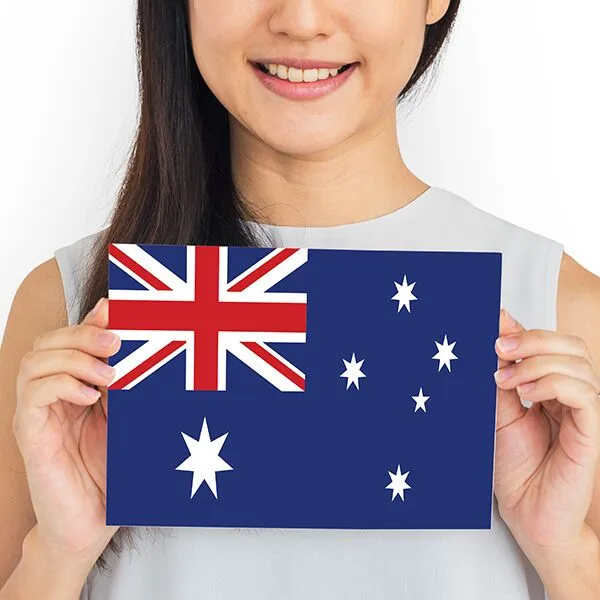Study in Australia

About Australia
Australia is the sixth-largest country in the world. Approximately half of the population in Australia resides along the eastern and southeastern coasts. If you are considering furthering your education to pursue a world-class degree, Australia offers a wide range of opportunities. Whether you plan to enhance your technical skills by pursuing a master's degree in engineering, broaden your language proficiency with a language course, opt for a humanities program, or refine your skills through an MBA, Australia offers exceptional quality of education along with a high standard of living and support for international students.
BOOK AN APPOINTMENT
Why Study in Australia?
Popular Destination Among Indian Students
Australia's quality of education, wide range of courses, and post-study work opportunities make it a desirable destination.
Internationally Accredited Qualifications
Australian qualifications are globally recognized, and universities are renowned for research and training.
Financial Assistance from the Government
The Australian government offers over £200,000,000 in scholarships to international students.
Lingual Diversity
Australia offers international exposure with over 200 languages spoken in the country.
Rights for International Students
When it comes to Australian education and the implementation of rights and consumer protection, no other country can compare.
Advantages - Study in Australia
- Global Demand: 5,40,000 International students each year in Australia
- Diversity: 90+ Nationalities study in Australian Institutions.
- International Recognition: 8 out of 39 Universities are in top 100 World Ranked
- World of Choices: 25,000+ courses are available to Study in Australia
- Best in World: 39 world-class universities offer Quality Education
- Only ENGLISH: No other Tests required except an English Proficiency Test
- Career Prospects: Work Rights for International Students
- Easy Progression for Indian Students: 10+2+3 Education System is acceptable
- NOOSR Classification of Indian Universities and Institutions

Australian Qualifications Framework (AQF)
The unique factor of the Australian Education System is its establishment in 1995, specifying the standards of Education and Training.
Types of Tertiary Institutions
- Universities
- TAFE Institutes
- Private Colleges
Types of Degrees
- VET Courses
- Bachelor’s Degree
- Master’s Degree
- Ph.D. Degree
English Language Requirements
Aspirants who are applying for undergraduate and postgraduate engineering programs must have an overall IELTS band score of 6.5, with no individual sub-score less than 6.0.
Tuition Fees
The tuition fees at Australia’s tertiary institutions range between AUD$20,000 and AUD$30,000 a year.

Expenditure Guide for Australia
Studying abroad can be a costly endeavour, but with smart budget planning, you can effectively manage your finances.
- Tuition fees are your primary expenditure: The cost of tuition fees varies depending on the type of qualification and the university or school you choose.
- Calculate accommodation costs: Most universities in Australia offer on-campus residence facilities for international students.
- Consider the cost of your student visa: Your first step in studying in Australia is to secure a valid student visa, which comes with its own associated costs.
Simplified Student Visa Framework - Australia
The Australian Government introduced student visa changes known as the SSVF (Simplified Student Visa Framework) on 1st July 2016, replacing the SVF (Streamlined Visa Framework). The primary purpose of these rule changes is to simplify the process for genuine students.
The most significant change in the SSVF is the consolidation of all student subclasses into one subclass, namely Subclass 500. This new framework provides a streamlined and unified immigration process for all international students, replacing the previous SVP (Streamlined Visa Processing).
Genuine Temporary Entrant (GTE) Requirement:
The GTE requirement is a measure implemented under the SSVF (Simplified Student Visa Framework) and was also part of the SVF (Streamlined Visa Framework). Its purpose is to ensure that the student visa program is used as intended, rather than as a means for international students to gain entry into Australia. The GTE requirement applies to all international students planning to pursue education in Australia.
Students from high-risk countries are required to provide more extensive proof of meeting the GTE criteria compared to students from low-risk countries. To meet the GTE requirement, you should address the following criteria:
- Be realistic in your statement.
- Explain your personal circumstances in your home country.
- Describe why you chose the specific education provider.
- Provide evidence of research on your intended courses and their expected outcomes.
- Explain the future value of the course you intend to study.
- Outline your immigration history.
- Explain why you chose to study in Australia in comparison to your home country and other countries.
- Submit supportive documents.
- Meet the financial requirements.
Student Visa Requirements for Australia
Applying for an Australian student visa? Here’s help!
The Australian Government offers an opportunity to all domestic students to study in the country but as a prerequisite, you’ll have to obtain a student visa first.
Documents required for an Australian student visa
- Proof of enrolment (your electronic confirmation of enrolment)
- A valid passport
- Your visa application fee
- Your Genuine Temporary Entrant statement
- Academic and work experience documents
- Evidence of your English proficiency skills
- Evidence of financial ability
- Details of your health insurance policy
- Statement of purpose


Top Courses to Study in Australia
- Accounting
- Arts and Design
- Business and Management
- Computer Science and IT
- Education and Training
- Engineering
- Health and Science
Living cost of Australia
While not being remarkably economical, Australia is still cheaper than many western countries. As an international student, you are supposed to pay the tuition of the course well in advance. Here are some examples of course costs in Australian Dollars:
| Institution/Degree | Annual Cost* |
|---|---|
| School | $30,000/- Per Year |
| Undergraduate Program | $15,000 – $33,000/- |
| Post-Graduate Program | $20,000 – $37,000/- |
| Doctoral Degree | $14,000 – $37,000/- |
*Note: This doesn’t include high-valued courses like veterinary and medicine.
The cost of living in Australia is around $1,400 - $2,500/- which would cover all expenses like accommodation, food, travel, and social activities.
Important Updates
1. Extension of Post-Study Work Rights
The Australian Government has extended post-study work rights for international graduates in high-demand fields. Effective from July 1, 2023, eligible graduates receive an extra two years.
- Bachelor's work rights extend from 2 to 4 years.
- Master's work rights extend from 3 to 5 years.
- PhD work rights extend from 4 to 6 years.
2. Increase in Work Hours Cap from July 1, 2023
International students can now work up to 48 hours per fortnight, up from the previous 40-hour limit.

